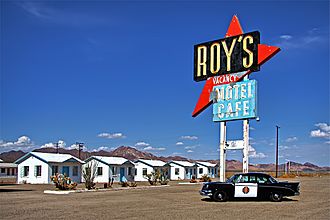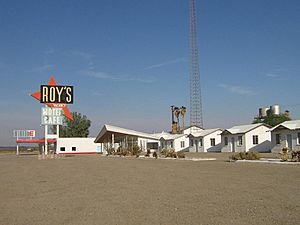Roy's Motel and Café facts for kids
Quick facts for kids Roy's Cafe and Motel |
|
|---|---|

Roy's Motel and Café in Amboy, California on U.S. Route 66 in California in the Mojave Desert, in 2012
|
|
| General information | |
| Architectural style | Modernism |
| Location | Amboy, California, United States |
| Completed | 1938 |
Roy's Motel and Café is a famous spot along U.S. Route 66 in the Mojave Desert. It's located in a small town called Amboy. This historic place used to be a motel, a café, a gas station, and even an auto repair shop. For many years, it was closed, but now it's being brought back to life! Roy's is a great example of a cool, modern building style from the middle of the last century, often seen at roadside stops.
The whole town of Amboy, including the Roy's complex, is owned by someone who wants to protect its history.
Contents
A Look Back: Roy's History
Roy's on Route 66
In 1938, a man named Roy Crowl opened Roy's. It started as a gas and service station in Amboy. At that time, U.S. Highway 66 was a super important road. People called it the "Main Street of America." It stretched all the way from Chicago to Los Angeles. Roy's was built when Route 66 was changed to go through Amboy. This made it a perfect stop for travelers.
In the 1940s, Roy Crowl worked with his son-in-law, Herman "Buster" Burris. They made the business bigger. They added a café, a car repair garage, and small cabins for people to stay overnight. Buster Burris was amazing! He almost single-handedly built the town's infrastructure, like bringing power to Amboy. He even set up his own poles and wires from Barstow using an old Studebaker pickup truck.
After World War II, business at Roy's really took off. Families loved traveling by car again. During the war, things like tires and gasoline were hard to get. New cars weren't being made much either. Roy Crowl and Buster Burris kept Roy's Garage and Café open 24 hours a day, seven days a week. It was so busy that Buster even put ads in newspapers to find more workers!
By the early 1950s, Roy's had about 70 employees. That's a lot, especially since the whole town of Amboy only had 700 people back then.
In 1959, Roy's Motel and Café got some cool new looks. They put up a huge neon sign that looked like a boomerang. You could see it for miles! They also built a new, modern-looking building for the motel's front desk. These new features made Roy's a famous landmark and a modern place for travelers for over ten years.
After Interstate 40 Opened
In 1972, a new highway called Interstate 40 in California opened. This highway was far north of Amboy and Route 66. This meant that Roy's suddenly lost almost all its customers. Buster Burris said his business "went down to zero" the day I-40 opened. Roy Crowl passed away in 1977. Buster Burris kept the business going for the few travelers who still used the old, scenic Route 66.
Even as Amboy became quieter, Roy's Motel and Café remained the only business in town, besides a post office. It still attracted visitors, including some famous people, even after the town started to decline.
Timothy White's Time
In 1995, a famous New York photographer named Timothy White rented the whole town of Amboy and Roy's from Buster Burris. White thought the old, worn look of the property would be great for filming movies and photos. He hired his friend Walt Wilson to manage the place. Later, in February 2000, White bought the entire town for $710,000 from Burris. Buster Burris passed away later that year, on August 10, 2000, at 91 years old.
Wilson and White continued to sell gas, food, and Route 66 souvenirs at Roy's. However, the hours were not regular, and the food menu was small. Gas and water were also very expensive because the place was so far away from everything. For example, a single glass of tap water in the café reportedly cost $1.00! In 2003, Timothy White tried to sell Amboy on eBay, but it didn't sell.
Bringing Roy's Back to Life
In February 2005, the property went into foreclosure. This meant Timothy White and Walt Wilson lost control. Ownership of Amboy and Roy's went back to Bessie Burris, Buster Burris's widow. She tried to sell the property, but no one showed up to bid. With help from her granddaughter, Bonnie Barnes, Bessie Burris decided to sell the town to the highest bidder one Friday in March 2005.
The town was finally sold in May 2005 to Albert Okura. He is a supporter of preserving old places from Southern California. Okura promised Bessie Burris that he would restore Roy's. He wanted to keep its original historic Route 66 look and feel. He also planned to reopen it and create a new museum about Amboy's history. Okura bought the town and Roy's Motel and Café for $425,000 on May 3, 2005.
Albert Okura, who owns the Juan Pollo chain of restaurants, faced challenges. He had to get basic services like electricity and water working again. Most of Amboy's systems were old, built by Buster Burris himself, and didn't meet modern building rules. Bessie Burris continued to visit and help Albert Okura collect memorabilia for the town until she passed away at 91 on May 17, 2008.
Okura has experience with preserving historic sites. He owns the Original McDonald's in San Bernardino, California, which he runs as a museum. Unlike Wilson and White, who wanted Roy's to stay "weathered" for film shoots, Okura plans to fully restore Roy's. He wants it to be a "nostalgia tourist" spot. It will also be a rest stop for travelers going to and from the Colorado River area.
Reopening Roy's
The first parts of Roy's to be fixed up and reopened were the coffee shop and gas station. They opened on April 28, 2008. So far, fixing up Roy's Motel and Café has cost about $100,000. The gas is still expensive because it's so far to deliver it. But it's not as expensive as it was during the Wilson and White years. Albert Okura also wants to open a Roy's Café and a small convenience store. However, the kitchen in the café is still closed because there isn't enough clean drinking water.
In 2013, a project on Kickstarter suggested restoring the famous Roy's neon sign. This was part of a bigger plan by a new group called the Amboy Foundation of Art. They hope to fix up the old motel. Their idea is to create a place in the desert where artists can find peace and inspiration.
The motel part of Roy's is currently closed. However, it has been used for art shows and exhibits.


